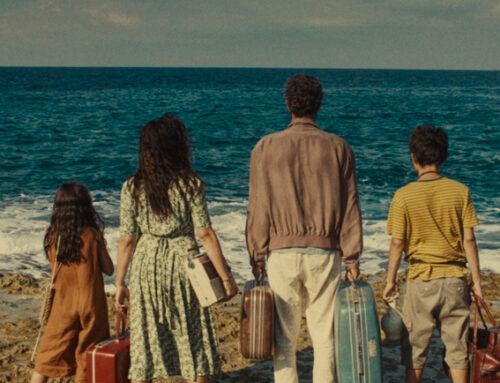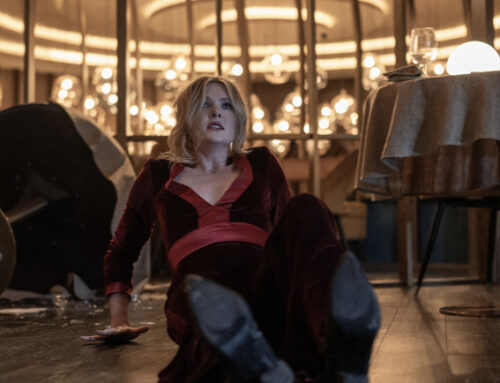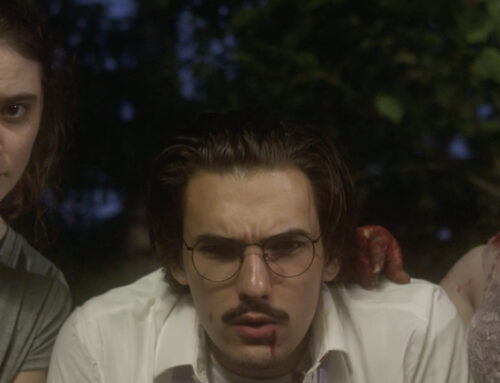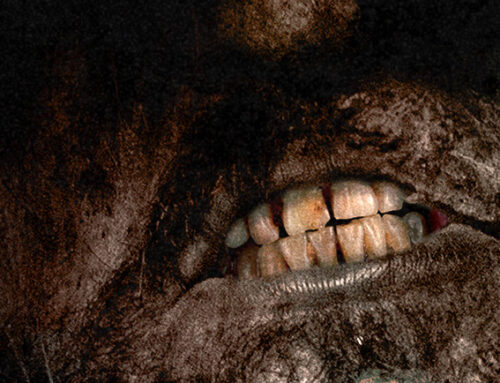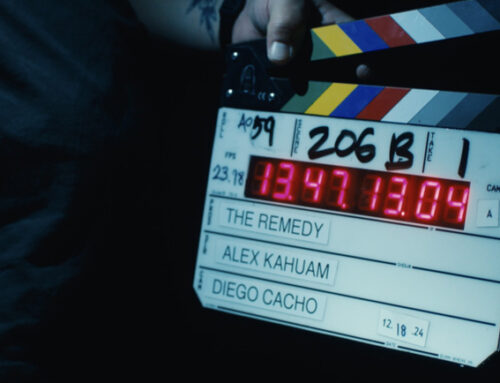I recently caught up with Vivian Kerr, one of the most exciting multi-hyphenates in the ever-evolving world of independent film. She is currently enjoying the success of her first two features – Scrap and Séance. After a successful festival run, Scrap is finally available on VOD, so audiences should absolutely go check it out. Séance remains a festival darling, having first premiered at the Newport Beach Film Festival in October.
I had the privilege of checking out this chilling chamber drama before connecting with Kerr on its complex mix of atmosphere and emotion. The film centers on an unlikely gathering in a Victorian mansion in 1892 California, where the unstable Lillian (Kerr) decides to host a séance for her deceased daughter, enmeshing her husband Albert and his ex-wife Emma in her haunting grief. With painterly cinematography from DP Johanna Coelho and gorgeous production design from Bri Jones, Kerr’s Séance stands out as one of 2024’s most impressive slices of indie horror. Kerr excels both in front of and behind the camera, and she is joined by a talented cast of supporting actors in Scottie Thompson and Connor Paolo.
Check out my full discussion with Vivian Kerr below, where we dive into the rising star’s creative process on the film, and even debate some of the film’s more supernatural occurrences.
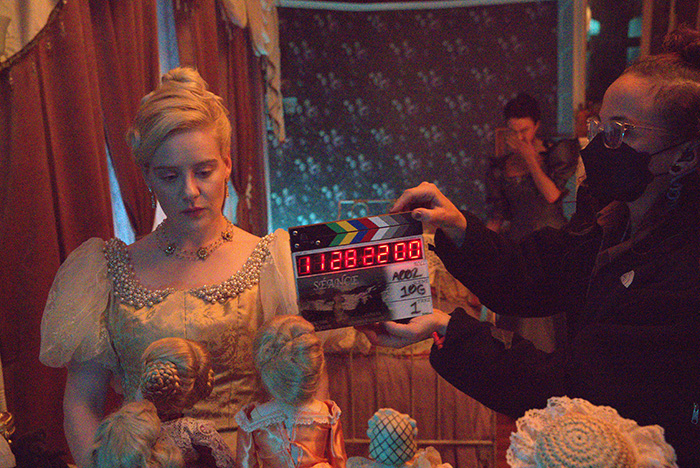
Hi Vivian! Séance is a deeply atmospheric film with a haunting sense of tension. What inspired you to blend elements of Victorian drama with supernatural horror, and how did you develop the tone of the film?
In 2020, I was trying to raise the money for my first feature Scrap, and one of the hurdles was that the film had over two dozen locations. I suddenly had so much more time to write because of the COVID lockdown, so I decided to try to come up with a more contained film, but didn’t have a sense of what the story would be about thematically. I still have a huge number of plays from my undergraduate Theatre major days at USC, so I started looking through small-cast plays, just kind of browsing for general inspiration.
I picked up a Strindberg play called Creditors that I had never read. It only has three characters — a woman and her second husband vacationing by the seaside, and her first husband who unexpectedly appears. It has all that kind of twisty subtext you always get with Strindberg and suddenly I thought that something like that set in the world of The Innocents could be very interesting if you had competing storylines around grief and adultery. Other than a couple lines of dialogue I lifted for the character of George, Séance really doesn’t have much in common with the play, but it was a great jumping off point.
Tonally, I was really interested in exploring sound design and quiet moments. I didn’t want the film to be over-scored. The film is only 85 minutes, so I felt like I could take a risk, especially in the first third of the film and really sit in the silences. That’s what Chekhov’s plays do so well. So I wanted to pay homage to the 19th century theatrical style with the tone and dialogue, but keep the acting raw and modern.
The film’s setting, a grand Victorian mansion, plays an essential role in establishing the eerie mood. How did you approach the environment and the use of space in creating a sense of claustrophobia and suspense throughout the film?
The setting was crucial. I looked at over 30 historic homes all over Los Angeles. I was naively hoping to find one house that would have all the rooms we needed, but we ended up shooting in 3 different historic homes because I was very particular about the look of each room. The reason I chose the rooms we used was partially to invite a sense of claustrophobia.
Victorian homes aren’t actually that grand spatially. They can be very narrow with some really ornate fixtures and paneling, so it was figuring out how to keep that feeling while still giving us the room we needed for our camera and lights. I did not want to shoot on a lot of wide angle lenses and wanted to stay away from that 1970s horror aesthetic, so it was a tricky balance. And I also was very open to inspiration from some of the cool original features at the locations.
The chandelier in the séance scene was actually part of the original house which was built in the 1890s. It was not heavily featured in the script originally, but it became the crux of the scene once we had that location. We also did a lot of wallpapering and repainting. All the white and cream-colored walls were painted a reddish blood-looking brown. I wanted everything to be very dark on the edges of the frame so a single candle would really stand out. We even painted the ceilings. I kept insisting it should feel like a “cave” with the only light from the fireplaces and candles. Our production designer Bri Jones did an absolutely terrific job.
The séance scene is a pivotal moment in the film, setting the stage for the unsettling events that follow. How did you approach crafting this scene to ensure it was both unsettling and deeply connected to the characters’ psychological states?
The séance scene was shot over 2 days. I definitely wanted to give us extra time, and it took the longest to storyboard. My brilliant DP Johanna Coelho and I spent several days in that room with a prop table just circling it and making notes and taking reference photos. We really had to choreograph it precisely, not just for eyelines and achieving the practical effects, but also for tracking the characters’ emotional arcs.
We broke it up into sections and then within each section gave ourselves a number of specials to really highlight each character. There’s a shot in the film where we rack focus from Emma’s hands to Albert when he asks, “did you bump it?” And that’s the first time we see he’s getting unnerved. So there were just certain shots like that we knew we weren’t covering the whole scene, but I wanted to grab as many of those tiny moments so I could play with it all in the edit and have options on whose POV to connect to in various moments.
The séance starts with our widest shot of us coming down the stairs. Then we move to the dolly to create the atmosphere with very slow tracking, and then we go in tighter and tighter until the end. And these were our most fun days on set, even though it’s unsettling on screen. I mean, God bless these other three actors, Jilon VanOver, Scottie Thompson, and Connor Paolo. They were just 100% game for whatever I asked them to do. They spent two full days sitting at a table, staring at both their hands and the ceiling, reacting to essentially nothing. There was a lot of giggling.
The tension between the living and the dead is central to Séance. How do you think grief and unresolved emotions play into the supernatural occurrences in the story?
That’s really the fun of this genre. Robert Wise’s The Haunting has that famous scene where all the characters are in the living room and the entity is upstairs making a banging sound while everyone is looking around at one another. That entire thing is created in the sound design and the acting! At the end, you wonder, because you never saw a “ghost,” if it’s possible it was all in the characters’ minds?
In Séance, George and Lillian are deeply in the throes of grief, and you have Emma who feels very trapped and unhappy in her marriage, as well as Albert who is trapped almost inside his own body. Similarly, you could interpret the entire film as something that happened because of their psychological distress. Or maybe there is a ghost! It’s open to interpretation.
As the writer and director, how did you approach the task of creating a character like Lillian, who is both fragile and manipulative in her grief? Was there a particular aspect of her character you wanted to explore to evoke sympathy yet unease in the audience?
That’s interesting you think Lillian is manipulative! She is, in a way. She needs to find closure from her daughter’s passing, and she latches on to Emma knowing that if she can befriend this woman, she might be able to convince George to do the séance so they can contact their child. With Lillian, my goal was to try to explore different sides of her in every scene. She has a child-like quality, but I also interpreted her as an old soul. And I think there’s a funny, mischievous quality to her, too. You can tell she enjoys it a little when Emma is scared in Hazel’s bedroom. There’s a dash of Mrs. Danvers in there. But even though she is carrying this profound grief, I didn’t want to lose the part of her that made George fall in love with her, either. As a director, I believe that first and foremost, you have to buy the relationships or a movie like this doesn’t work.
The characters in Séance are confined within the house due to the storm, which makes the film feel like a chamber piece. How did you use this limited setting to heighten the tension and develop the mystery surrounding Lillian’s past?
Absolutely it’s a chamber piece. I wanted it to feel like a play, and funny enough, some people have actually asked me if I would consider adapting it into a stage production, and I can see it working in the theatre, so we’ll see if that happens!
Though the setting was contained, we were able to have these important props that carried a lot of emotional weight for the characters — Hazel’s doll, Emma’s painting, George’s pocket-watch, Albert’s sketchbook. These items all added to the mystery because the cast did such a great job imbuing them with emotional resonance and investing in making the backstories real. Connor Paolo, who plays Albert, did such a phenomenal job taking ownership over Albert’s drawings. Every time I watch the film I completely believe he’s an artist. He would sometimes be off to the side sketching in between takes.
How did you prepare for your complex performance as Lillian, and were there specific emotional beats or traits you focused on to bring her grief to life?
I am very lucky to work with an incredible acting coach named Saxon Trainor, and she and I met several times in the weeks leading up to the shoot. It’s important for me to have someone to talk to where I can take off my “director hat” and get into actor shop-talk. And not to sound too actor-y, but during the pre-production period, I was going through a lot in my personal life and I honestly didn’t have to scrape too deeply to understand Lillian’s feelings of abandonment and loss.
I really have to thank our costume designer Nina Fuller and our hair/make-up department Lauren Litwin and Danielle Beyea. They really helped support me emotionally through what was a difficult role and journey and I felt they really cared for “Lillian,” which was so nice on set to have that from your crew.
I remember shooting a scene with Scottie in the nursery and I have this line, “I thought I could trust you…” and on the day it just hit me like a ton of bricks. We actually had to VFX my close-up because I had mascara smudges from so much crying. It was intense, but I found it incredibly cathartic. Sometimes these punishing roles can help you process things in a healthy way.
The performances of Scottie Thompson and Connor Paolo also play off your character’s tension and mystery. How did you create that dynamic between Lillian, Emma, and Albert to build the uncertainty and suspicion that escalates throughout the film?
We didn’t have any time for rehearsal, and you never really do on an indie like this, so I got incredibly lucky with my cast. We had one dinner all together before we shot, which was going to be a potential readthrough, but ended up just being us sitting at Scottie’s house, eating dinner and bonding.
It was really their talent that created the dynamic. Scottie Thompson is a wildly intelligent actress and she brought so much depth and ferocity to Emma. I knew that energetically we would be a great contrast to one another. And then Connor Paolo is just a delight. I remember one night shooting a scene with all of us and his coverage got pushed to the very end. It was 3am and I started apologizing and he said to me, “Vivian, there’s nowhere else I’d rather be.” And he meant it. He’s an actor’s actor. I adore him.
Can you discuss how you worked with Johanna Coelho on cinematography to create that painterly, dimly lit aesthetic that feels so integral to the film?
I cannot overstate how much I owe Johanna Coelho. Her work on this film is stunning and truly everything I ever imagined it could be. She was at a disadvantage in a way, because I actually had prepped the film almost completely with another DP, but then he left the project to shoot a sketch comedy series.
So suddenly I had to bring on Johanna and it must have been challenging for her because there were locations I already was incredibly familiar with that she had never even seen and I’d already decided I wanted the 1.85 ratio and certain compositions, but it actually worked out beautifully. We pushed the shoot back nine weeks so she and I could re-prep from scratch and it was the best decision I made to start fresh like that. She came in and blew it all up in the best possible way and really made the film her own.
We took the time to go to Keslow and do camera and lens tests and really get into the nitty-gritty on just how far we could push the Sony Venice with the low-light. She gave me so much more control over the image, more than any DP ever has, and she taught me a lot. She was on board with all the practical flame I wanted and letting the film be dark. She never once said “no” to anything I wanted, even when it was going to make our days a lot harder, and she was the one who suggested we shoot on Super Baltars, which now I can’t even imagine what it would have been like to not use them.
The day she suggested putting Vaseline on the lens for a couple shots, I knew she was someone I could take risks with and it became very exciting. During filming, we were running around like mad women, shooting twilight waist-deep in the ocean, and blacking out pools to try to get wide shots underwater, and there was a lot of pressure because of the budget and time constraints. But she had my back completely and her immense talent is why the film looks so beautiful and painterly. I also have to thank Wes Turner, our Steadicam Operator. We had hardly any time with him and he nailed some long, important sequences.
Our whole camera department crushed it, and JoJo’s leadership made it all happen. I really want to work with her again, but now she’s shooting 15 episodes of The Pitt for Max, so she’s probably going to get too big for my independent films pretty soon!
The ending of Séance includes a twist that leaves viewers questioning what they’ve seen. What was your intention behind that final revelation, and how do you want it to affect the audience’s perception of the entire film?
I wanted to have a fun “button” as these kinds of films often do, so it really is up to the audience for interpretation. But I see it that the experience Lillian has been through will never fully leave her; whether it’s trauma or that she is literally being haunted is up to the audience to decide! I sort of think of it like Ophelia in ‘Hamlet.’ When she goes mad, you could interpret it as grief from Polonius’s death, or she could be insane. It’s possible Lillian has just been through too much and cannot be fixed. Or, again, possibly a dead little girl ghost!
After Séance, do you see yourself continuing to explore the psychological or supernatural horror genres? What other types of narratives or themes would you like to tackle in future projects?
I have this fantasy of going out to the Midwest and shooting Days of Heaven, but don’t we all? I think it’s all the travel I did for my first feature Scrap in the past two years. I saw so much of America that I had never seen and got to have my Travels with Charley moment. Now I’m desperate to shoot something outside of Los Angeles. I really want to make something that emphasizes landscape and place.
I’d absolutely do more psychological drama or supernatural, but the two feature scripts I’m writing now are more drama/thriller, and I suppose one could be described as sci-fi adjacent. On Séance, because there were so many different aspects to the shoot— stunts, underwater work, practical effects, Steadicam, etc. — I feel like I am ready to raise the bar even more on my third feature. I learned so much.
There isn’t really anything I’m too intimidated to try now and it was fun to have a bigger budget and play with fancier toys. I never even had a jib on my first feature, and suddenly on Séance I had everything. I loved learning how to choreograph all of that and connecting it to the heart of the piece. Combining a sense of emotional grounding and intimacy within larger scale set-pieces is something that really excites me, and I’m grateful to be learning more technical aspects of filmmaking. I really love doing things practically, but I would also do something with green-screen. I’d go shoot a Star Wars movie if I could!
But on the near-horizon, there’s a short I’ve written that I’d love to shoot in 2025 on 16mm. It feels like the right piece to shoot on film and I’ve never shot on film, so that’s a dream I’d like to fulfill. My main goal is to stretch and grow as a director and continue to work closely with stellar cinematographers such as Johanna who push the envelope. Exploring different ways of telling stories visually is the highest priority for me. It feels like everything has kind of opened up after Séance and now I’m ready to play ball.

